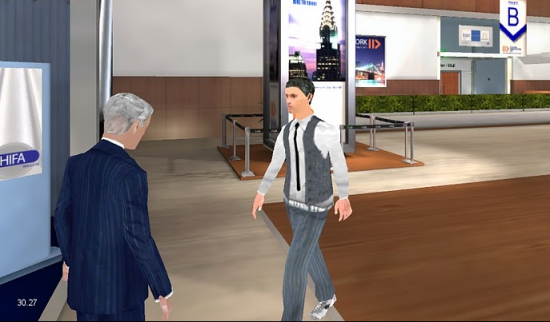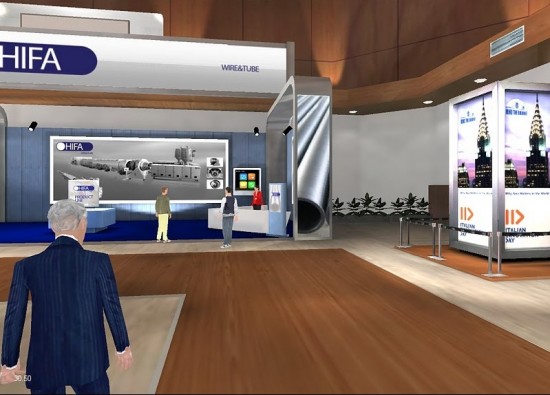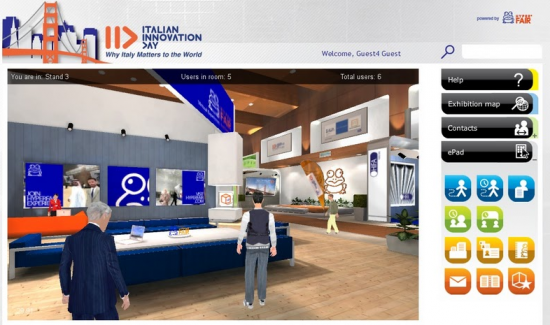San Francisco-based Hyperfair is the first to offer a fully immersive 3D exposition hall focusing on large-scale business expos.

“We want to become the global reference model,†Max Bonfanti, the company’s  CTO and co-founder, told Hypergrid Business. “All our competitors rely on 2D.â€
The founders spent two years building the platform, on top of Unity 3D, with an initial investments of “a few hundred thousand euro,” and the company is planning to scale up fast. Slightly more than ten people work on the project, mostly in expanding technical features. Talks with outside venture investors are underway, but Bonfanti declined to share any additional details.
The originally Italian company, now based in an incubator in California, is not short of ambition: their technology tested a situation with up to 50,000 avatars in three connected regions, according to Bonfanti, because it is based on cloud computing and can scale up pretty fast.
It looks like there is no real maximum for the number, although it seems unlikely that a situation with more than 50,000 avatars would be needed.
Their closest competitors would be Unity 3D-based virtual platforms Jibe and Unifier and, after that, VenueGen, Avaya’s Web.Alive, Altadyn’s 3DXplorer, and Assemblive. They use their systems typically for small group meetings, not large conventions.
Another potential competitor is Digitell’s VirtualU, which can handle up to 1,000 avatars on its Activeworlds-based platform, but requires that users download separate viewer software to access the 3D environment.
Scene-based, not region-based
Like other enterprise-grade platforms, Hyperfair is based on individual scenes of arbitrary size, linked together by teleports. (By comparison, Second Life and OpenSim are based on a checkerboard layout, and users can walk or fly between adjacent regions.)
The default conference setup comes with three pre-built scenes, and chatting and interacting is limited to people within that same scene.
The platform was used to host the Italian Innovation Dayin New York in May of this year. Three more events are scheduled for later this year.

Avatars can move around, exchange business cards, visit booths where they can download  and watch brochures, videos, pictures and meet company representatives. Voice is only available in seminar rooms, in-world users have to rely on text chat. At the time of our tour, no seminar was taking place, so we could not test the voice system.
The whole area was covered with a background noise of conference hall chatter, even though it looked pretty empty. The event organizer could only address us over a public chat system, not through a centralized voice system. Initially, the artificial chatter creates a bit of atmosphere, but later become more a nuisance.
I was provided with a ready-for-use avatar, and the system did not allow me to change clothes, and did not allow facial expressions. Walking is still a bit clumpsy and my fellow visitors regularly made walking movements, without actually moving ahead.
An expo map allows you to jump between rooms, your travel history is saved, together with the files you want to download for later export.
For those who have been professionally browsing exposition halls, loaded with bags full of promotional materials, the advantages are obvious.

Looking for expo partners
The plan for Hyperfair is to team up with expo organizers, who can offer a virtual mirror of a real exposition, that could be up in the months before or after the real exposition. The costs should be covered by an upcharge of 20, 30 percent on top of the fee exhibitors and sponsors would pay anyway.
“When you think about a normal fee of 10,000 euro, that would mean about 2,000 euro per booth extra,†said Bonfanti.

Hyperfair focuses on the technology, and hope that expo organizers will take on the sales part of the business.

“What Hyperfair offers is like a huge expo hall,†German expo veteran Hans Gaeng told Hypergrid Business. “What happens inside the expo hall is up to the exhibitors. Sales is also to be done by their partners.â€
That does means a rather conservative industry has to be convinced about the huge advantages — instead of physically receiving 100,000 visitors, brochures and talks can be exchanged without huge costs. For those working in virtual worlds, that might be a no-brainer, but does need a rather drastic cultural change among the exhibitors, sponsors and visitors, who are less familiar with the technology.
Breaking through those cultural inhibitions might in the end be more problematic than the technological challenges, although by linking up to the existing expos, it might be possible to facilitate a transition into virtual worlds. Despite the some of its usability issues, if it is able to scale as it promises, Hyperfair would be a significant breakthrough, that might set a new standard for the exposition industry, and for other virtual events as well.
- Hyperfair offers 3D conference halls - August 26, 2011
